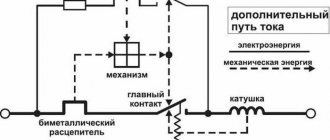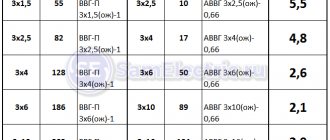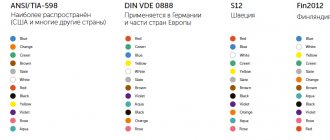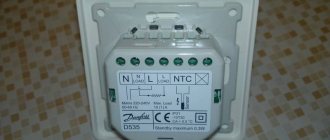The vast majority of cables have different colors of core insulation. This was done in accordance with GOST R 50462-2009, which sets the standard for ln marking in electrical installations (phase and neutral wires in electrical installations). Compliance with this rule guarantees fast and safe work for a technician at a large industrial facility, and also allows you to avoid electrical injuries during independent repairs.
Variety of colors of electrical cable insulation
The color marking of wires is varied and varies greatly for grounding, phase and neutral conductors. To avoid confusion, the PUE requirements regulate what color ground wire to use in the power supply panel, and what colors must be used for zero and phase.
If the installation work was carried out by a highly qualified electrician who knows modern standards for working with electrical wires, you will not have to resort to using an indicator screwdriver or a multimeter. The purpose of each cable core is deciphered by knowing its color designation.
Set of tools for connecting a single-gang switch
To perform electrical work, you first need:
- turn off the power supply to the line;
- make sure there is no voltage;
- protect yourself from unauthorized switching on of electric current.
Using a special indicator, the phase wire coming into the junction box is determined. When found, you must mark it with a marker.
Then the tools are prepared:
- voltage indicator;
- pliers;
- screwdriver;
- marker;
- construction knife.
All these tools are freely available and inexpensive.
Ground wire color
From 01/01/2011 the color of the grounding (or grounding) conductor can only be yellow-green. This color marking of wires is also observed when drawing up diagrams on which such conductors are signed with the Latin letters PE. The coloring of one of the conductors on cables is not always intended for grounding - usually it is done if there are three, five or more conductors in the cable.
PEN wires with combined “ground” and “zero” deserve special attention. Connections of this type are still often found in old buildings, in which the electrification was carried out according to outdated standards and has not yet been updated. If the cable was laid according to the rules, then blue insulation was used, and yellow-green cambrics were put on the ends and joints. Although, you can also find the color of the grounding (grounding) wire exactly the opposite - yellow-green with blue tips.
The grounding and neutral conductors may differ in thickness; they are often thinner than the phase conductors, especially on cables that are used to connect portable devices.
Protective grounding is mandatory when laying lines in residential and industrial premises and is regulated by PUE standards and GOST 18714-81. The neutral grounding wire should have as little resistance as possible, the same applies to the grounding loop. If all installation work is carried out correctly, then grounding will be a reliable protector of human life and health in the event of a fault in the power line. As a result, correctly marking cables for grounding is critical, and grounding should not be used at all. In all new houses, wiring is done according to the new rules, and old ones are put in line for replacement.
Installing a cable responsible for turning on a specific lighting fixture
It is almost impossible to determine this without an electrician’s tool. In practice, such a connection is usually established experimentally. For this purpose, the unoccupied ends with the current conductor in the terminal are checked one by one using a voltage indicator. In this way you can see which lamps light up.
The switching element can be connected to the network arbitrarily, with the exception of the “L” terminal. In the case when it turns out that the terminals are accidentally confused, you need to swap the wiring L2 and L3 in the 2-key device.
When there are 3 or 4 terminals for connecting to the network, and the element is single-key, then you have encountered a type of switching device.
Type of connections for connecting lamps Source asutpp.ru
Colors for neutral wire
For “zero” (or zero working contact) only certain wire colors are used, also strictly defined by electrical standards. It can be blue, light blue or blue with a white stripe, regardless of the number of cores in the cable: a three-core wire in this regard will be no different from a five-core wire or with an even larger number of conductors. In electrical circuits, “zero” corresponds to the Latin letter N - it participates in closing the power supply circuit, and in circuit diagrams it can be read as “minus” (phase, respectively, is “plus”).
Specifics of connecting a single-phase switching device to the network
To understand the specifics of connecting a standard version of a switching device, you need to know the principle of its operation. This was mentioned in the article a little earlier.
Connection features:
- The light switch is always installed with a break in the current-carrying conductor.
The 2nd end of the wiring is laid to the distribution box (distribution box) or directly connected to the lighting fixture.
- There are only 2 cables on both sides of the terminal.
Each of these 2 wires has its own purpose. The first connects a single-phase circuit breaker located in the switchboard to the switch. This wire is always under (220 V) voltage. The other conductor has no current, since it is a neutral wiring. If you connect this wire to a lamp, the lamp will not light up, since there is no voltage in it.
When the key is moved to the “On” position, 220 V is supplied to the single-phase switch (depending on the model of the element). After this, the working lighting device or lamp lights up.
Features of connecting a single-phase switch Source extremale.ru
Colors for phase wires
These electrical wires require especially careful and “respectful” handling, since they are live, and careless touching can cause severe electric shock. The color marking of wires for connecting a phase is quite varied - you cannot use only colors adjacent to blue, yellow and green. To some extent, it is much more convenient to remember what the color of the phase wire may be - NOT blue or cyan, NOT yellow or green.
On electrical circuits, a phase is designated by the Latin letter L. The same markings are used on wires if color markings are not used on them. If the cable is intended to connect three phases, then the phase conductors are marked with the letter L with a number. For example, to draw up a circuit for a three-phase 380 V network, L1, L2, L3 were used. In electrical engineering, an alternative designation is also accepted: A, B, C.
It is strongly recommended to use the same colors of wires when branching a single-phase circuit from a three-phase one.
Before starting work, you need to decide what the color combination of wires will look like and strictly adhere to the chosen color.
If this issue was thought through at the stage of preparatory work and taken into account when drawing up electrical wiring diagrams, you should purchase the required number of cables with cores of the required colors. If you still run out of the required wire, you can mark the wires manually:
- ordinary cambrics;
- heat-shrinkable cambrics;
- electrical tape.
About the standards for color marking of wires in Europe and Russia, see also this video:
Plus and minus symbol
The standards used will vary depending on what country the wiring is in, the type of electricity, and other factors. Learning about the different options that can be used in a given situation is important for workplace safety.
Plus and minus
When connecting to a DC source, 2 or 3 wires are usually used. The coloring looks like this:
- Red - “+” plus wire;
- Black - “-” minus wire;
- White or gray - ground wire.
Note! Reliable and legible markings must be provided at the interface where new and old versions of the fixed wiring color code exist. The warning notice must also be prominently displayed on the relevant switchboard controlling the circuit.
Manual color marking
It is used in cases where during installation it is necessary to use wires with cores of the same color. This also often happens when working in old houses, in which electrical wiring was installed long before the advent of standards.
To avoid confusion during further maintenance of the electrical circuit, experienced electricians used kits that allow them to mark phase wires. This is also allowed by modern rules, because some cables are manufactured without color and letter designations. The place where manual marking is used is regulated by the rules of the PUE, GOST and generally accepted recommendations. It is attached to the ends of the conductor, where it connects to the bus.
Marking of two-core wires
If the cable is already connected to the network, then to search for phase wires, electricians use a special indicator screwdriver - its body has an LED that lights up when the tip of the device touches a phase.
True, it will only be effective for two-wire wires, because if there are several phases, then the indicator will not be able to determine which one is which. In this case, you will have to disconnect the wires and use a dialer.
Next, you will need a set of special tubes with a heat-shrinkable effect or insulation tape to mark the phase and zero.
The standards do not require such markings to be made on electrical conductors along their entire length. It is allowed to mark it only at the places of joints and connections of the necessary contacts. Therefore, if there is a need to apply marks on electrical cables without markings, you need to purchase materials in advance to mark them manually.
The number of colors used depends on the scheme used, but there is still a main recommendation - it is advisable to use colors that eliminate the possibility of confusion. Those. Do not use blue, yellow or green marks for phase wires. In a single-phase network, for example, the phase is usually indicated in red.
Marking three-wire wires
If you need to determine phase, zero and grounding in three-wire wires, you can try to do this with a multimeter. The device is set to measure alternating voltage, and then carefully touch the phase with probes (you can also find it with an indicator screwdriver) and the two remaining wires in series. Next, you should remember the indicators and compare them with each other - the phase-zero combination usually shows a higher voltage than phase-ground.
When phase, zero and ground are determined, markings can be applied. According to the rules, a yellow-green colored wire is used for grounding, or rather a core with this color, so it is marked with electrical tape of suitable colors. Zero is marked, respectively, with blue electrical tape, and the phase is any other.
If during preventive maintenance it turns out that the marking is outdated, it is not necessary to change the cables. In accordance with modern standards, only electrical equipment that has failed can be replaced.
How to check the correctness of the markings in the apartment?
Relying on color alone is not recommended.
Before starting work, it is recommended to check their belongings. A special screwdriver is used for this. The LED on it lights up when you touch the phase. There will be no problems with a two-core cable, because the second one will be zero. For three-wire, use another tool - a multimeter or tester.
The switch is set on a scale greater than 220V. This indicator or even less should be displayed on the screen, because these are our realities.
To use a multimeter, it is worth considering that when ringing a phase-ground pair, the readings are lower than when ringing a phase-zero pair.
When connecting wires, try to use wires of the same color. Try not to confuse them so as not to face disastrous consequences - injuries or fires.
Tips for working with “probes”
When using a test lamp, you need to be as careful as possible.
In addition to the fact that a person can be electrocuted, if the lamp is connected incorrectly, it will explode and injure a person with glass fragments. When making voltage indicators yourself, you need to choose a metal rod that will not exceed two centimeters. Otherwise, you may touch the work surface with your hand, which will result in an electric shock. In addition, it is recommended to attach a protective ring on the side of the rod, which will not allow your hand to slip off the body.
The indicator uses a light bulb that can withstand more than 90V. The material for making the device must be dark in color, which will allow you to notice the glow of the light bulb. It is better to make the device from ebonite. When working with electrical appliances, you must follow safety regulations.
If a person does not understand electricity and is also not confident in his abilities, then it is better to ask a specialist to do the work with electrical wiring. This way you can avoid unpleasant consequences that can arise from the slightest mistake.
Is zero on the right or left in old sockets?
To connect an old-style socket, only two wires are used - one phase, the other neutral.
The phase can be connected to the right or left. Some modern electrical appliances are connected strictly according to the instructions, and therefore the location of the phase wire plays an important role. Installation is carried out only by professionals. For example, a gas boiler that has a built-in electrical controller that does not have a plug and is therefore permanently connected.
The location of the phase is not indicated in the rules for installing electrical appliances. Electricians adhere to a certain standard: phase on the right side, zero on the left.











